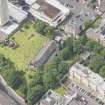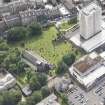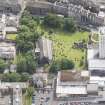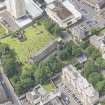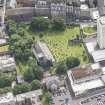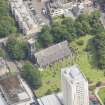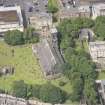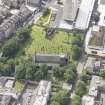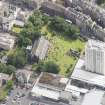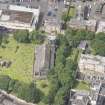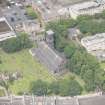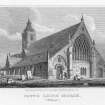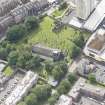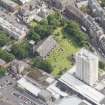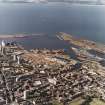Edinburgh, Leith, Kirkgate, South Leith Parish Church, Churchyard
Churchyard (Post Medieval), Inhumation(S) (Medieval), Unidentified Pottery(S) (Post Medieval)
Site Name Edinburgh, Leith, Kirkgate, South Leith Parish Church, Churchyard
Classification Churchyard (Post Medieval), Inhumation(S) (Medieval), Unidentified Pottery(S) (Post Medieval)
Alternative Name(s) Constitution Street
Canmore ID 254437
Site Number NT27NE 30.01
NGR NT 27044 76040
Datum OSGB36 - NGR
Permalink http://canmore.org.uk/site/254437
- Council Edinburgh, City Of
- Parish Edinburgh (Edinburgh, City Of)
- Former Region Lothian
- Former District City Of Edinburgh
- Former County Midlothian
INVENTORY OF GRAVEYARD AND CEMETERY SITES IN SCOTLAND REFERENCE:
Address: South Leith Parish Church Churchyard, Kirkgate, Edinburgh
Postcode: EH6 6BJ
Status: Closed for burials but maintained
Size: 0.61 hectares, 1.51 acres
TOIDs:
Number of gravestones: Not known
Earliest gravestone: Not known
Most recent gravestone: Not known
Description: Burial ground associated with a church
Data Sources: OS MasterMap checked 20 September 2005; Bereavement Services Portal checked 20 September 2005
Project (1997)
The Public Monuments and Sculpture Association (http://www.pmsa.org.uk/) set up a National Recording Project in 1997 with the aim of making a survey of public monuments and sculpture in Britain ranging from medieval monuments to the most contemporary works. Information from the Edinburgh project was added to the RCAHMS database in October 2010 and again in 2012.
The PMSA (Public Monuments and Sculpture Association) Edinburgh Sculpture Project has been supported by Eastern Photocolour, Edinburgh College of Art, the Edinburgh World Heritage Trust, Historic Scotland, the Hope Scott Trust, The Old Edinburgh Club, the Pilgrim Trust, the RCAHMS, and the Scottish Archive Network.
Field Visit (24 April 2002)
Standing stone composed of a triangular pediment (top) carved with a horse and cart in low relief, and an inscription panel (below).
The stone is from the Convening House of the Incorporation of Carters.
Inspected By : I.C. Grant
Inscriptions : Below carving of horse and cart (incised letters):
INCORPORATION OF CARTERS / CONVENING HOUSE LEITH
On panel below (incised letters): BUILT 1726, REBUILT 1802. / Great God, whose potent Arm drives the sun / The Carters bless while wheels of Time shall run. / of old they Drove thy Sacred Ark O God / Guide thou their hands and Steps in every road, / protect this house we Dedicate to thee, / Increase and sanctify our Charity. / Thy blessing Lord be its foundation stone / And we'll ascribe the praise of thee alone.
Signatures : None
Design period : 1802
Information from Public Monuments and Sculpture Association (PMSA Work Ref : EDIN0835)
Trial Trench (22 September 2008 - 2 October 2008)
An archaeological evaluation was undertaken on Constitution Street, Leith during September and October 2008. The aim was to establish the former extent of the South Leith Parish Church graveyard which had been cut through in the 18th century with the construction of Constitution Street and its housing.
The deposits beneath the road are likely to be made ground. The sandy deposit, into which the service trenches were cut was probably used to create a level surface for the road. The presence of disarticulated
human bone in this made ground suggests that at least some of it originated from the original graveyard and at may have been deposited when the tenements, which have basements, were constructed on the eastern side of Constitution Street. The graves were more numerous on the western side where they had been less disturbed. They were cut into a graveyard soil that was present at a depth of c 0.8m. This was found on the western side of both trenches and in the centre of Trench 2 where burials were also encountered. The graveyard soil in the centre of Trench 2 had been truncated leaving only a small area undisturbed. It occurred at a similar depth as that found to the west but the burials in this area occurred 0.3m into the graveyard soil, at a depth of 1.1m below the present road surface, suggesting that the profile in this area was more complete.
Information from Ross Murray (Headland Archaeology) December 2008. OASIS ID: headland1-51073
Excavation (15 April 2009 - 22 September 2009)
Headland Archaeology Ltd was commissioned by Transport Initiatives Edinburgh (tie) Limited to carry out archaeological works comprising the excavation of the remains of the post-medieval graveyard associated with South Leith Parish Church in advance of the main tram track construction (INFRACO) in Constitution Street. The excavation yielded 302 inhumations within a variety of grave types. Constitution Street, adjacent to the graveyard wall of the local parish church, was built in 1790 to improve access to the harbour. Despite the proximity to a known graveyard, the density and preservation of graves was unexpected, as the extent of burials was thought not to have gone much beyond the existing graveyard wall. No finds of human remains had been reported previously, despite evidence that many burials had been cut by modern services. The graves, orientated WNW-ESE, were arranged in closely spaced rows. The majority were single, supine extended inhumations interred in wooden coffins or in earthen graves. Also present were shrouded bodies placed in simple graves, group burials in irregular pits including superimposed double burials, usually of a child and an adult. Most artefacts were iron coffin nails, with a few shroud pins. A copper buckle was found in one grave, along with textile remains of clothing worn by the deceased. Documentary and pottery evidence point to a date in the 16th and 17th centuries for most graves, and all pre-date construction of Constitution Street c.1790. There is a strong possibility however that earlier medieval burials are located in the cemetery, possibly associated with the 15th-century hospital and chapel which stood on and close to the present church. Radiocarbon dating and further stratigraphic analysis may give us a more accurate picture of their chronology.
Headland Archaeology 2009 (S. Spanou) OASIS ID: headland1-150108





































